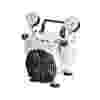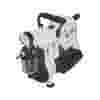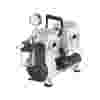What is a Piston Vacuum Pump?
A piston vacuum pump is a specialized type of pump that operates using a unique piston mechanism to create a vacuum. This mechanism involves the movement of a piston within a cylinder to generate a low-pressure environment by removing air or gas molecules from a confined space. As the piston moves, it creates suction that draws in the surrounding air or gas, effectively creating a vacuum within the system. This technology is widely used in various applications, ranging from industrial processes to laboratory experiments, where the creation of a controlled vacuum environment is essential for specific tasks.
Where Are Piston Vacuum Pumps Required?
Piston pumps are reliable, dry vacuum/pressure pumps suited for a wide array of physical and aqueous vapor applications. Designed without the need for corrosion resistance (please note their unsuitability for pumping acidic, basic, or organic fumes), these oil-free vacuum pumps are recommended in a wide range of standard duty applications in both laboratory and industry, including:
- Laboratories: Essential for tasks like sample preparation, controlled environments, and filtration in scientific experiments like DNA/RNA extraction.
- Analytical Instruments: Enables precise measurements in gas chromatographs and spectrometers.
- Industrial Manufacturing: Used in vacuum drying, casting, and packaging processes to enhance overall product quality.
- Pharmaceuticals: Integral to critical processes like freeze-drying and solvent removal, ensuring the purity and stability of products.
- Food Processing: Ensures high-quality products with extended shelf life and preserved flavors during packaging and processing.
- Automotive Testing: Essential for brake system testing, emission control, and leak detection.
- Research Facilities: Used in experiments, mass spectrometry, electron microscopy, and more.
- HVAC Systems: Evacuates and maintains vacuum in refrigeration and air conditioning units.
- Environmental Monitoring: Enables accurate air and gas sampling for pollution control and assessment.
- Material Handling: Removes air and gas from materials during molding and curing processes.
What Are the Advantages of Piston Vacuum Pumps?
Piston pumps remain one of the most popular and most widely used vacuum technologies. Welch’s WOB-L® dry piston vacuum pumps provide you with several benefits to help you improve and streamline your mission-critical vacuum processes. They include:
- Enhanced Performance: WOB-L® piston technology ensures exceptional vacuum and flow capabilities within a compact package, delivering reliable performance across various applications.
- Dependable Operation: Crafted with quality materials and unique design features, WOB-L® pumps minimize maintenance needs and promise an extended product lifespan, ensuring reliable operation over time.
- Controlled Vacuum: Equipped with regulators and gauges, WOB-L® pumps offer straightforward adjustment and monitoring of vacuum levels, allowing tailored control as per your requirements.
- Protection Mechanism: An inlet water trap safeguards the pump from inadvertent water intake, preserving its performance integrity, even in challenging conditions.
- Motor Safety: All WOB-L® models feature 1PH motors with built-in thermal overload protection, providing an added layer of safety to your vacuum processes.
What Types of WOB-L® Piston Vacuum Pumps Are There?
Welch offers a diverse portfolio of WOB-L® piston pumps to meet various needs and applications. Choose from:
Single Stage Vacuum Pressure Stations:
- These pumps are available in three sizes and include inlet/outlet gauges, traps, and vacuum/pressure control valves. They are ideal for applications like vacuum filtration aspiration and tissue culture filtration, known for their quiet operation.
- Models 2511, 2522, 2534, 2546, 2567, and 2685.
Dual Stage Vacuum Pumps with Catch-Pot and Regulator:
- These pumps offer high flow rates and deep vacuum capabilities, making them perfect for drying and degassing applications. They feature a convenient catch-pot with built-in vacuum regulation and a dial vacuum gauge.
- Models 2561, 2562, 2563, and 2581.
Single Stage Vacuum Pumps with Catch-Pot and Regulator:
- Designed for tasks such as aspiration, vacuum chucking, and multi-funnel filtration manifolds. They come with a catch-pot featuring built-in vacuum regulation and a gauge.
- Models 2567 and 2585
10 Gallon Tank Mounted Vacuum System (model 8150):
- This system, equipped with an ASME 10-gallon receiver, is particularly suited for vacuum chucking, hold-down, pick place, and vacuum forming. It offers both continuous duty and automatic on/off functionality.
- Model 8150
What Are the Benefits of Oil-Free Operations?
Oil-free piston pumps offer a host of advantages for your operations:
- Environmental Friendliness: By eliminating the need for lubricating oil, these pumps reduce the risk of oil contamination, creating a cleaner working environment.
- Cost Savings: With no oil to purchase, handle, or dispose of, oil-free piston pumps lead to reduced operating costs over time.
- Maintenance Ease: These pumps require less maintenance compared to oil-based alternatives, translating to less downtime and increased productivity.
- Enhanced Product Purity: Oil-free operation prevents oil-related contamination, making these pumps ideal for applications requiring the utmost product purity.
- Lower Operating Temperatures: Without oil, these pumps run cooler, leading to longer component life and improved overall reliability.
How Does a Piston Vacuum Pump Work?
The operation of piston vacuum pumps revolves around a set of key components: an electric motor, a crankshaft, a connecting rod, and a piston enclosed within a cylinder. This mechanism functions based on the principle of positive displacement. The pump's motor imparts rotational energy to the crankshaft, initiating its rotation. Subsequently, the connecting rod converts this rotary motion into the reciprocal motion of the piston.
Within the cylinder, as the piston moves alternately up and down, a vacuum is created during its downward stroke. This action prompts the medium to be drawn into the cylinder chamber via an open inlet valve. Depending on the design, single or multiple cylinders may be linked to the motor. In the latter configuration, the pump's capability is amplified, whether in terms of flow (in a parallel setup) or vacuum (in a two-stage configuration).
A distinctive feature of WOB-L® vacuum pumps is the direct connection between the piston and the rod. Unlike conventional designs, there is no intervening wrist pin; the two components form a single unit. This direct coupling results in a characteristic wobbling motion of the piston. Guided within a flanged polymer cup, the piston moves within the cylinder bore, creating a seal against the cylinder wall.
As the piston moves, air pressure expands the cup against the cylinder wall, compensating for its wobbling action. This innovative design ensures exceptional vacuum capabilities relative to the pump's compact size and lightweight construction. Additionally, it maintains consistent moderate-to-high flows, contributing to sustained performance throughout the product's lifespan.


















